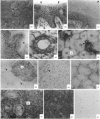Abstract
The CD47 glycoprotein was isolated from human erythrocytes by immunoprecipitation using monoclonal antibody (mAb) BRIC-125. Enzymic deglycosylation of the protein showed it contained N-linked oligosaccharides, and trypsin proteolysis of the protein in situ in the erythrocyte membrane cleaved it into two portions, one of which was glycosylated. Both the intact protein and the glycosylated fragment had blocked N-termini. Amino acid sequence was obtained from several proteolytic fragments of CD47. Comparison with the sequence database showed the protein to be very similar to or identical with OA3, a multispanning membrane protein. The protein also appears to be the same as the integrin-associated protein, which has a role in cell adhesion in non-erythroid cells. CD47 has six potential N-glycosylation sites, five of which are in an Ig superfamily domain. We show that three of these sites carry N-glycans in erythrocytes. Immunocytochemical staining of human tissues showed that CD47 was broadly distributed on mesenchyme and epithelia at multiple sites. Reactivity was particularly prominent in surface and ductular epithelia, and in the brain. The possible roles of the CD47 glycoprotein are discussed.
Full text
PDF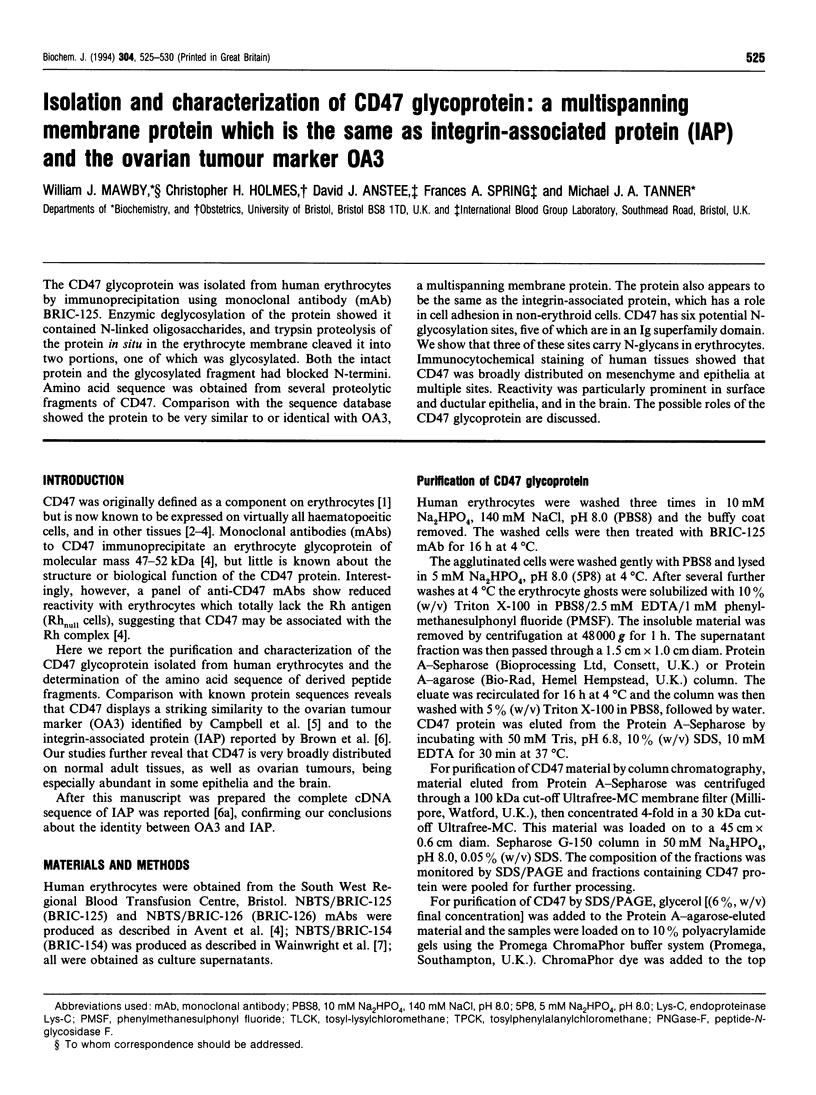
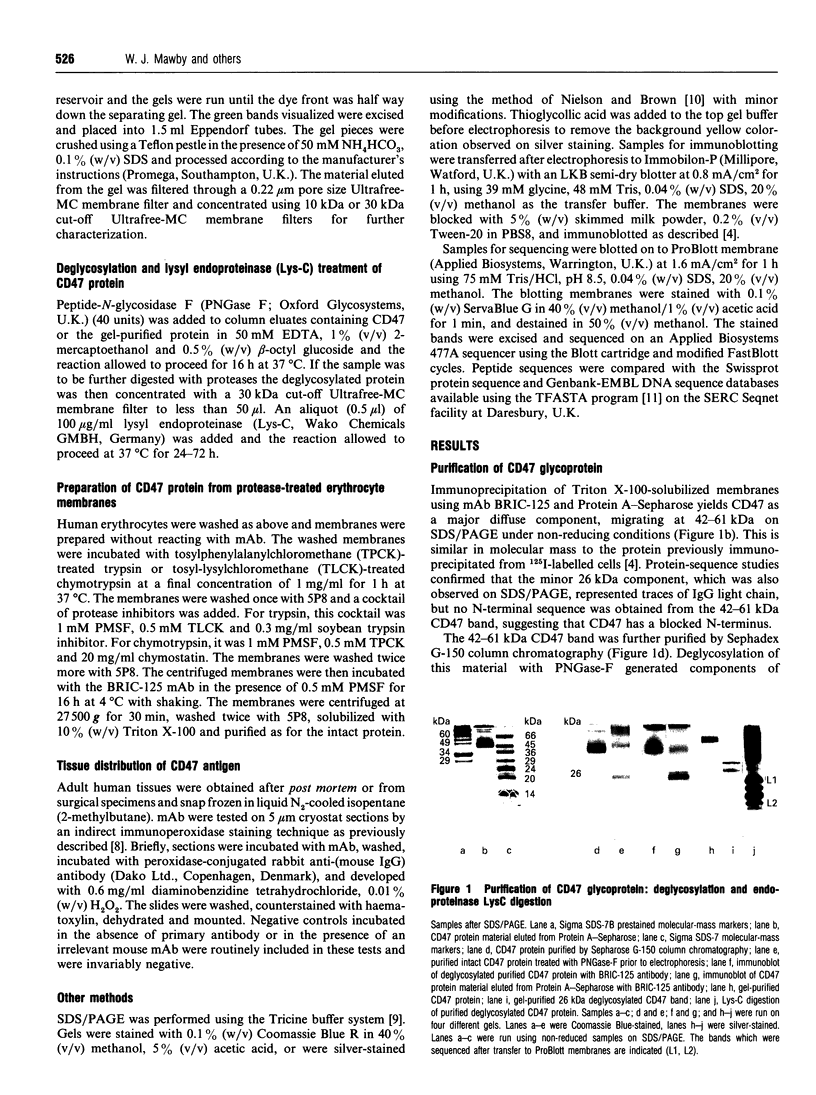
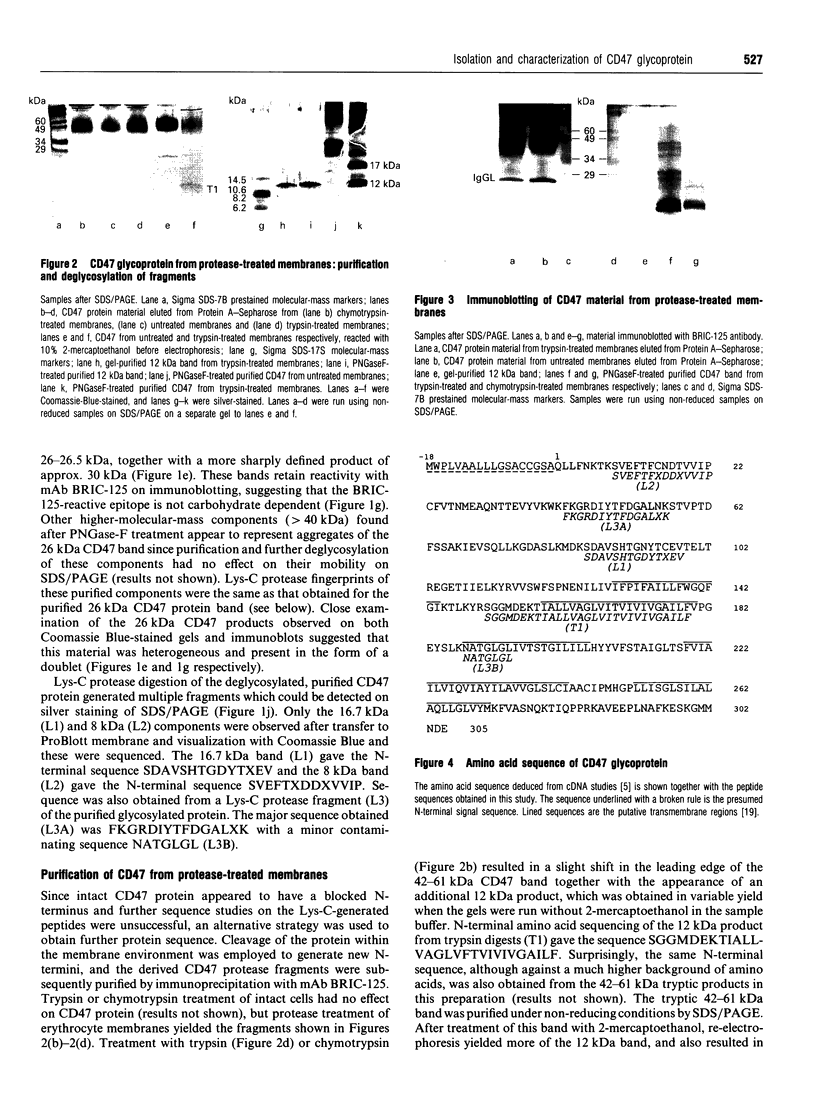
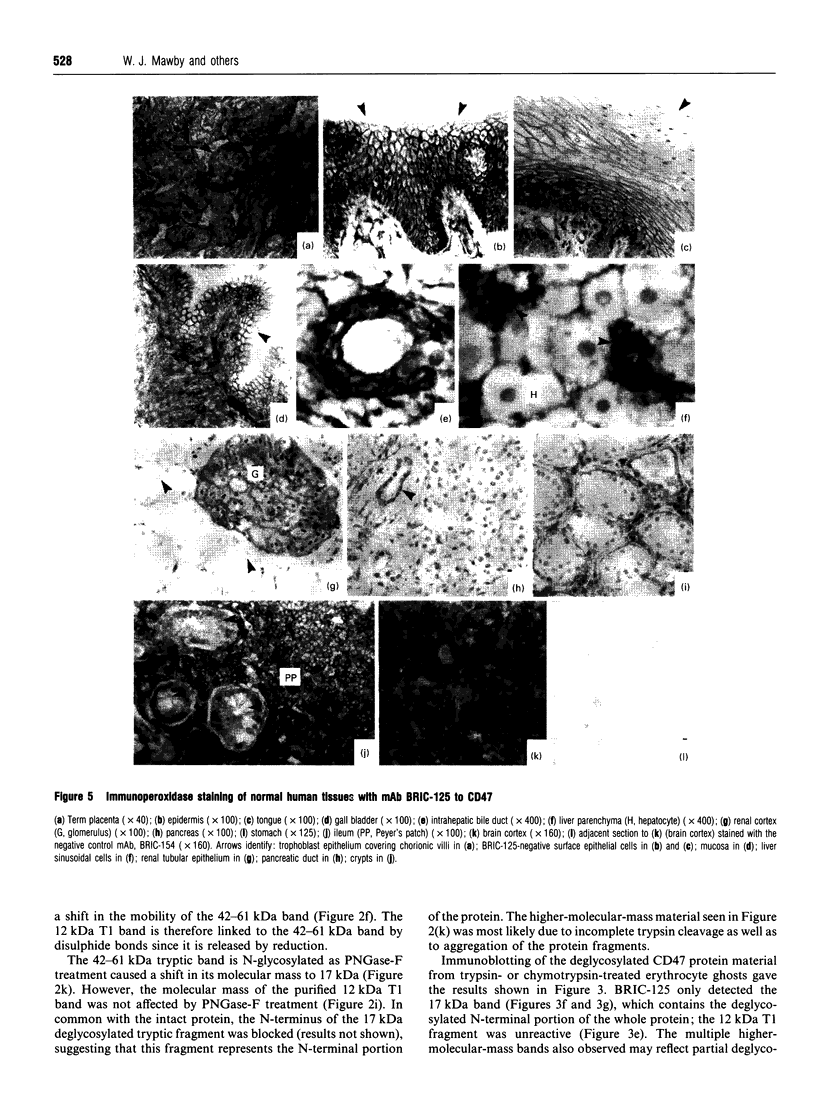
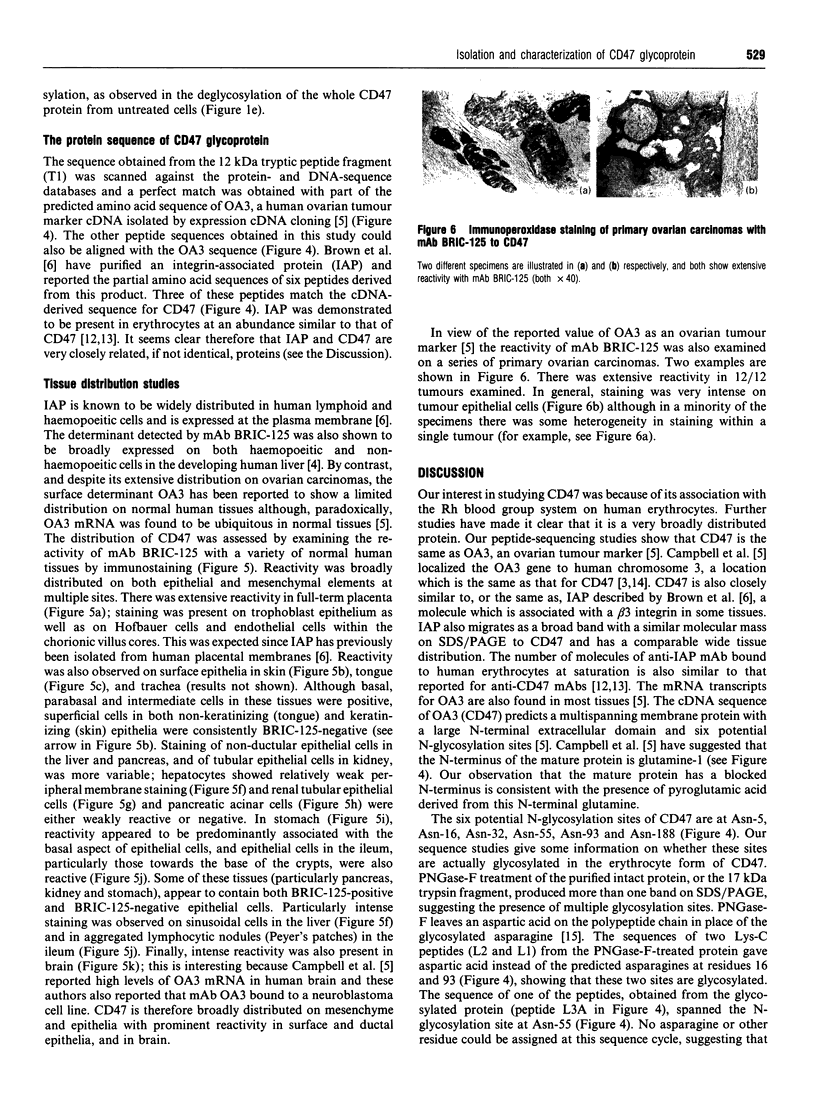
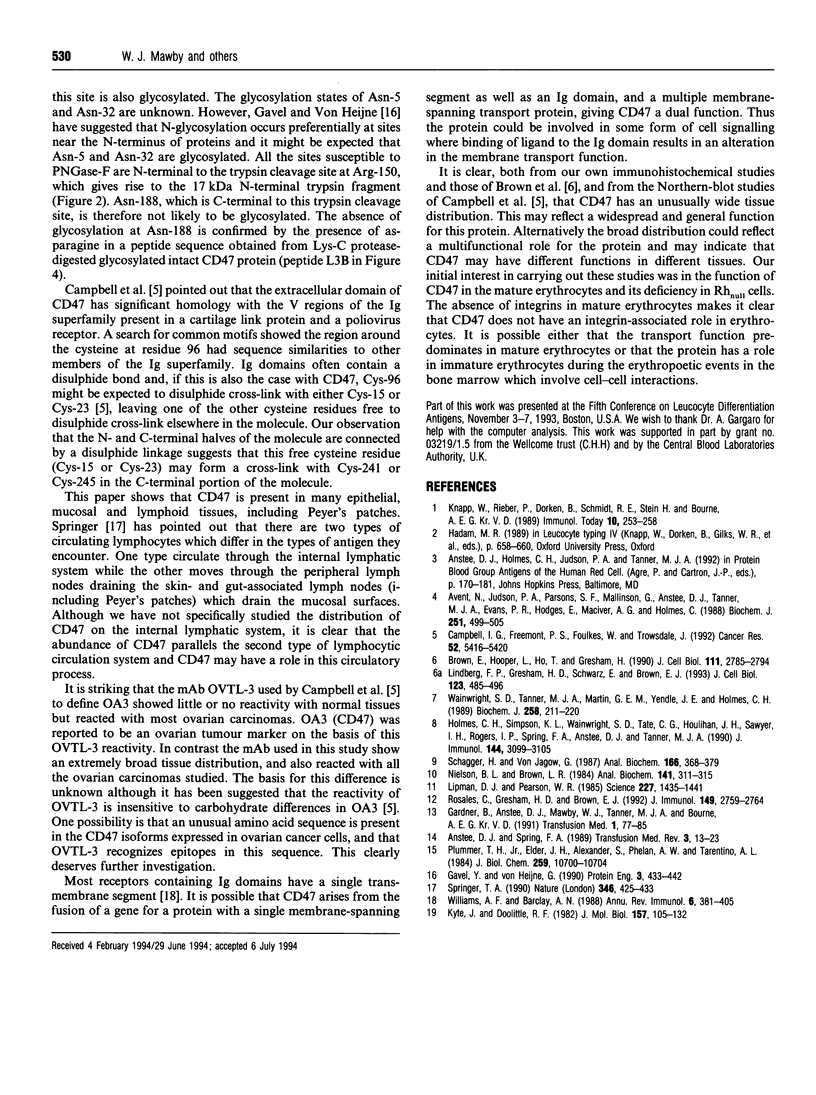
Images in this article
Selected References
These references are in PubMed. This may not be the complete list of references from this article.
- Anstee D. J., Spring F. A. Red cell membrane glycoproteins with a broad tissue distribution. Transfus Med Rev. 1989 Jan;3(1):13–23. doi: 10.1016/s0887-7963(89)70065-1. [DOI] [PubMed] [Google Scholar]
- Avent N., Judson P. A., Parsons S. F., Mallinson G., Anstee D. J., Tanner M. J., Evans P. R., Hodges E., Maciver A. G., Holmes C. Monoclonal antibodies that recognize different membrane proteins that are deficient in Rhnull human erythrocytes. One group of antibodies reacts with a variety of cells and tissues whereas the other group is erythroid-specific. Biochem J. 1988 Apr 15;251(2):499–505. doi: 10.1042/bj2510499. [DOI] [PMC free article] [PubMed] [Google Scholar]
- Brown E., Hooper L., Ho T., Gresham H. Integrin-associated protein: a 50-kD plasma membrane antigen physically and functionally associated with integrins. J Cell Biol. 1990 Dec;111(6 Pt 1):2785–2794. doi: 10.1083/jcb.111.6.2785. [DOI] [PMC free article] [PubMed] [Google Scholar]
- Campbell I. G., Freemont P. S., Foulkes W., Trowsdale J. An ovarian tumor marker with homology to vaccinia virus contains an IgV-like region and multiple transmembrane domains. Cancer Res. 1992 Oct 1;52(19):5416–5420. [PubMed] [Google Scholar]
- Gardner B., Anstee D. J., Mawby W. J., Tanner M. J., von dem Borne A. E. The abundance and organization of polypeptides associated with antigens of the Rh blood group system. Transfus Med. 1991 Jun;1(2):77–85. doi: 10.1111/j.1365-3148.1991.tb00013.x. [DOI] [PubMed] [Google Scholar]
- Gavel Y., von Heijne G. Sequence differences between glycosylated and non-glycosylated Asn-X-Thr/Ser acceptor sites: implications for protein engineering. Protein Eng. 1990 Apr;3(5):433–442. doi: 10.1093/protein/3.5.433. [DOI] [PMC free article] [PubMed] [Google Scholar]
- Holmes C. H., Simpson K. L., Wainwright S. D., Tate C. G., Houlihan J. M., Sawyer I. H., Rogers I. P., Spring F. A., Anstee D. J., Tanner M. J. Preferential expression of the complement regulatory protein decay accelerating factor at the fetomaternal interface during human pregnancy. J Immunol. 1990 Apr 15;144(8):3099–3105. [PubMed] [Google Scholar]
- Knapp W., Rieber P., Dörken B., Schmidt R. E., Stein H., vd Borne A. E. Towards a better definition of human leucocyte surface molecules. Immunol Today. 1989 Aug;10(8):253–258. doi: 10.1016/0167-5699(89)90135-7. [DOI] [PubMed] [Google Scholar]
- Kyte J., Doolittle R. F. A simple method for displaying the hydropathic character of a protein. J Mol Biol. 1982 May 5;157(1):105–132. doi: 10.1016/0022-2836(82)90515-0. [DOI] [PubMed] [Google Scholar]
- Lindberg F. P., Gresham H. D., Schwarz E., Brown E. J. Molecular cloning of integrin-associated protein: an immunoglobulin family member with multiple membrane-spanning domains implicated in alpha v beta 3-dependent ligand binding. J Cell Biol. 1993 Oct;123(2):485–496. doi: 10.1083/jcb.123.2.485. [DOI] [PMC free article] [PubMed] [Google Scholar]
- Lipman D. J., Pearson W. R. Rapid and sensitive protein similarity searches. Science. 1985 Mar 22;227(4693):1435–1441. doi: 10.1126/science.2983426. [DOI] [PubMed] [Google Scholar]
- Nielsen B. L., Brown L. R. The basis for colored silver-protein complex formation in stained polyacrylamide gels. Anal Biochem. 1984 Sep;141(2):311–315. doi: 10.1016/0003-2697(84)90047-2. [DOI] [PubMed] [Google Scholar]
- Plummer T. H., Jr, Elder J. H., Alexander S., Phelan A. W., Tarentino A. L. Demonstration of peptide:N-glycosidase F activity in endo-beta-N-acetylglucosaminidase F preparations. J Biol Chem. 1984 Sep 10;259(17):10700–10704. [PubMed] [Google Scholar]
- Rosales C., Gresham H. D., Brown E. J. Expression of the 50-kDa integrin-associated protein on myeloid cells and erythrocytes. J Immunol. 1992 Oct 15;149(8):2759–2764. [PubMed] [Google Scholar]
- Schägger H., von Jagow G. Tricine-sodium dodecyl sulfate-polyacrylamide gel electrophoresis for the separation of proteins in the range from 1 to 100 kDa. Anal Biochem. 1987 Nov 1;166(2):368–379. doi: 10.1016/0003-2697(87)90587-2. [DOI] [PubMed] [Google Scholar]
- Springer T. A. Adhesion receptors of the immune system. Nature. 1990 Aug 2;346(6283):425–434. doi: 10.1038/346425a0. [DOI] [PubMed] [Google Scholar]
- Wainwright S. D., Tanner M. J., Martin G. E., Yendle J. E., Holmes C. Monoclonal antibodies to the membrane domain of the human erythrocyte anion transport protein. Localization of the C-terminus of the protein to the cytoplasmic side of the red cell membrane and distribution of the protein in some human tissues. Biochem J. 1989 Feb 15;258(1):211–220. doi: 10.1042/bj2580211. [DOI] [PMC free article] [PubMed] [Google Scholar]
- Williams A. F., Barclay A. N. The immunoglobulin superfamily--domains for cell surface recognition. Annu Rev Immunol. 1988;6:381–405. doi: 10.1146/annurev.iy.06.040188.002121. [DOI] [PubMed] [Google Scholar]






